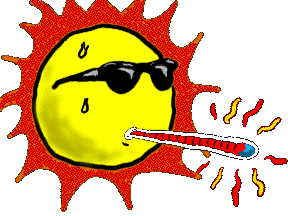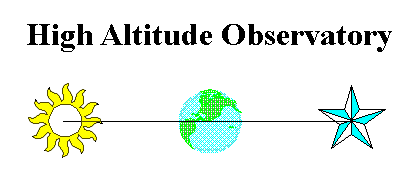 Stellar
Temperature Measurement
Stellar
Temperature Measurement



Do all the big words got you confused? Check out these
sites
for help.
ON-LINE GLOSSARY OF SOLAR-TERRESTRIAL
TERMS
or the
High-Energy Astrophysics Dictionary
Temperature Scales
There are several temperature scales in use today. One degree of
temperature
difference is not the same in the various scales, and which
temperature
is called zero degrees also varies. The two most widely used
temperature
scales for everyday use are the Fahrenheit and Celsius scales. A
temperature
scale that is used a lot in science (and astronomy in particular) is
the
Kelvin scale. These scales are described below:
Celsius scale
- The Celsius scale was invented by the Swedish astronomer Anders
Celsius (1701-1744, Sweden). It is fixed by two temperatures:
zero
degrees Celsius is the freezing temperature of water (at a standard
sea-level
air pressure), and a hundred degrees Celsius is the boiling
temperature
of water at the same pressure.
- The zero point of the Celsius scale is practical, because below
zero
degrees Celsius you have to watch for ice on the roads and for frozen
water
pipes.
- Zero degrees Celsius corresponds to 32 degrees Fahrenheit and
273.15 kelvin. A hundred degrees Celsius corresponds to 212 degrees
Fahrenheit
and to 373.15 kelvin. To change from degrees Fahrenheit to degrees
Celsius,
use this link: Temperature Conversion Calculator.
Fahrenheit scale
- The Fahrenheit scale was invented by the German scientist Daniel
Gabriel Fahrenheit (1686 Poland - 1736 Dutch Republic). It is
fixed
by two temperatures: zero degrees Fahrenheit was the temperature of a
mix
of water, ice, and salt. Ninety degrees Fahrenheit was what people in
those
days thought was the normal temperature of the human body.
- These two fixed points on the Fahrenheit scale were perhaps not
the
most practical choices, because most people do not spend a lot of
time
trying to keep water fluid by adding salt to it, and we now know that
the
temperature that people then thought was the normal temperature of
the
human body was in fact a few degrees wrong.
- Zero degrees Fahrenheit corresponds to about -17.8 degrees
Celsius
and about 255.4 kelvin. One hundred degrees Fahrenheit corresponds to
about
37.8 degrees Celsius and to about 310.9 kelvin. To change from
degrees
Fahrenheit to degrees Celsius, use this link: Temperature
Conversion Calculator.
Kelvin Scale
- The Kelvin scale is named after the British scientist Lord
Kelvin,
- (William
Thompson), Baron Kelvin of Largs. It is fixed by one temperature
and
a temperature difference: zero kelvin (don't say degree.
kelvin
and don't write kelvin with a capital K) is the lowest possible
temperature,
at which not even atoms move around anymore. A difference of one
kelvin
corresponds to a difference of one degree Celsius. This scale was
invented
by scientists for use in physics, because some formulas (those
relating
pressure of a gas to its temperature, or brightness to temperature,
for
instance) become easier if you use the zero point of the Kelvin
scale.
You'll notice that the formulas for the equilibrium temperatures
above
are also simpler when the Kelvin scale is used. The symbol for kelvin
is
K, so you can write 100 kelvin also as 100 K.
Zero kelvin corresponds to -273.15 degrees Celsius and to -459.67
degrees
Fahrenheit. A temperature difference of one kelvin corresponds to a
temperature
difference of one degree Celsius, and 9/5 = 1.8 degree Fahrenheit. To
change
from degrees Fahrenheit to degrees Celsius, use this link: Temperature Conversion Calculator.
- The National Institute of Standards and Technology (NIST)
maintains databases for standardizing thermometers.




 As you surf each web site listed below, look for
information
about the questions listed directly below. At the quiz
section,
you will be given an chance to check your learning.
As you surf each web site listed below, look for
information
about the questions listed directly below. At the quiz
section,
you will be given an chance to check your learning.
As a focus - keep the
following
questions in mind:
 What
is the Kelvin Scale ?
What
is the Kelvin Scale ?
 What
is the Celsius scale ?
What
is the Celsius scale ?
 What
is the Fahrenheit scale ?
What
is the Fahrenheit scale ?
 What
is the temperature of sunspots ?
What
is the temperature of sunspots ?



click
here to see the site
The
Solar-Terrestrial Physics division of the National
Geophysical Data Center is the focal
point
for data pertaining to solar
activity,
the ionosphere, and geomagnetic
variations.Ý



click here to see the
site
NRL
- Researchers in the Solar Physics Branch
of the Naval Research Laboratory have been involved in
observational
and theoretical studies of the solar atmosphere since the early years
of
the space age. Experiments developed at NRL have flown on NASA
missions
such as Skylab/ATM, the OSO satellite series, the Space Shuttle
STS-3,
Spacelab-2 and Atlas missions.
Take The On-Line Quiz prepared by
Stanford Solar Center Here 

Quicktake
Sunspot quiz. On this page, bite-sized portions of some of the
most
fascinating aspects about the Sun, in the form of questions. Along
the
way, we point to sources for more information so that you can explore
the
topics on your own ( Stanford
Solar Center) This site presents a collection of fun educational
activities
based on Solar Oscillations Investigation (SOI)
and Solar and Heliospheric Observatory (SOHO)
data.
Have a Solar
Question?
Then
ask a Solar Physicist !



Now.......Let's look at some HOT
images of the sun

Welcome to the High
Altitude Observatory, which is dedicated to the study of the Sun
and
of the response of the Earth's upper atmosphere to the Sun's output.
As
a National Science
Foundation sponsored laboratory, the High Altitude Observatory is committed
to
the dissemination of its new knowledge to the community at large. by
P.
Charbonneau and O.R. White.
Return to the Table of
Contents
Return to Beginning

 The Science Museum of
Virginia
The Science Museum of
Virginia
Copyright © 1997
Regents of the University of California. All rights reserved.
This page last updated 06/25/02
![]() Stellar
Temperature Measurement
Stellar
Temperature Measurement![]()
![]() Stellar
Temperature Measurement
Stellar
Temperature Measurement![]()



![]()













